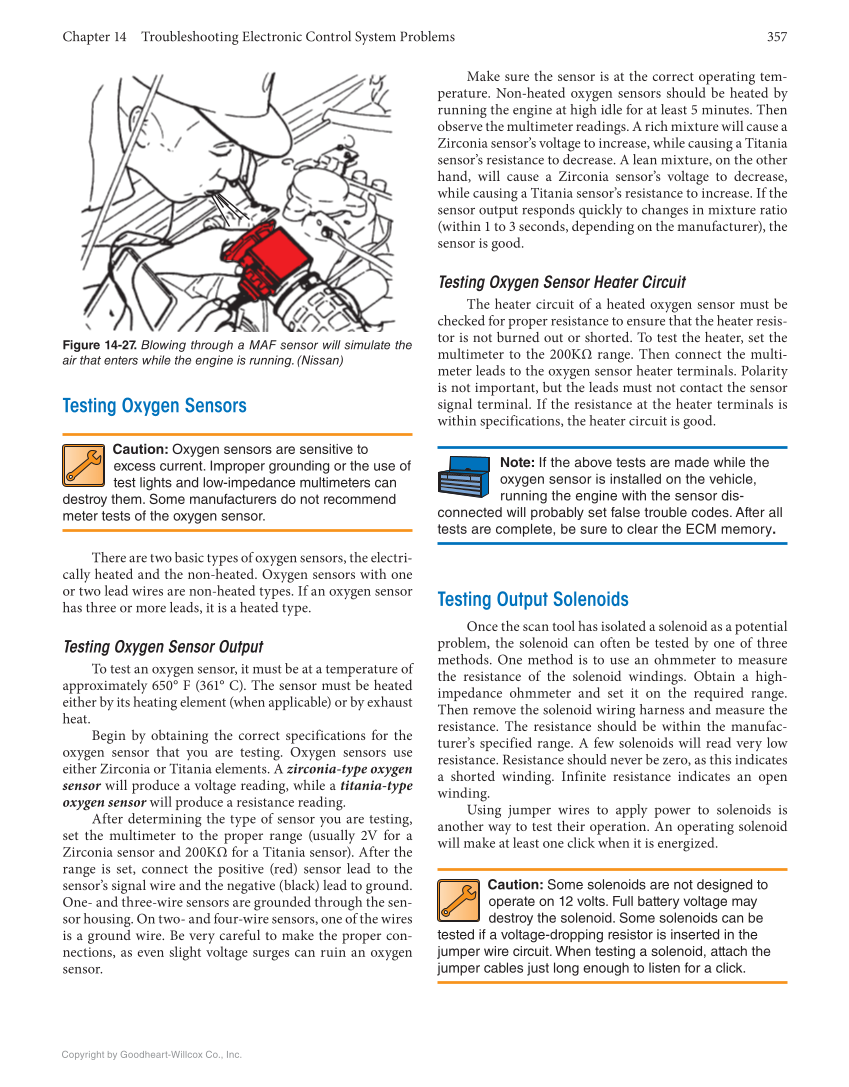Chapter 14 Troubleshooting Electronic Control System Problems 357 Copyright by Goodheart-Willcox Co., Inc. Testing Oxygen Sensors Caution: Oxygen sensors are sensitive to excess current. Improper grounding or the use of test lights and low-impedance multimeters can destroy them. Some manufacturers do not recommend meter tests of the oxygen sensor. There are two basic types of oxygen sensors, the electri- cally heated and the non-heated. Oxygen sensors with one or two lead wires are non-heated types. If an oxygen sensor has three or more leads, it is a heated type. Testing Oxygen Sensor Output To test an oxygen sensor, it must be at a temperature of approximately 650° F (361° C). The sensor must be heated either by its heating element (when applicable) or by exhaust heat. Begin by obtaining the correct specifications for the oxygen sensor that you are testing. Oxygen sensors use either Zirconia or Titania elements. A zirconia-type oxygen sensor will produce a voltage reading, while a titania-type oxygen sensor will produce a resistance reading. After determining the type of sensor you are testing, set the multimeter to the proper range (usually 2V for a Zirconia sensor and 200KΩ for a Titania sensor). After the range is set, connect the positive (red) sensor lead to the sensor’s signal wire and the negative (black) lead to ground. One- and three-wire sensors are grounded through the sen- sor housing. On two- and four-wire sensors, one of the wires is a ground wire. Be very careful to make the proper con- nections, as even slight voltage surges can ruin an oxygen sensor. Make sure the sensor is at the correct operating tem- perature. Non-heated oxygen sensors should be heated by running the engine at high idle for at least 5 minutes. Then observe the multimeter readings. A rich mixture will cause a Zirconia sensor’s voltage to increase, while causing a Titania sensor’s resistance to decrease. A lean mixture, on the other hand, will cause a Zirconia sensor’s voltage to decrease, while causing a Titania sensor’s resis tance to increase. If the sensor output responds quickly to changes in mixture ratio (within 1 to 3 seconds, depending on the manufacturer), the sensor is good. Testing Oxygen Sensor Heater Circuit The heater circuit of a heated oxygen sensor must be checked for proper resistance to ensure that the heater resis- tor is not burned out or shorted. To test the heater, set the multimeter to the 200KΩ range. Then connect the multi- meter leads to the oxygen sensor heater terminals. Polarity is not important, but the leads must not contact the sensor signal terminal. If the resistance at the heater terminals is within specifications, the heater circuit is good. Note: If the above tests are made while the oxygen sensor is installed on the vehicle, running the engine with the sensor dis- connected will probably set false trouble codes. After all tests are complete, be sure to clear the ECM memory. Testing Output Solenoids Once the scan tool has isolated a solenoid as a potential problem, the solenoid can often be tested by one of three methods. One method is to use an ohmmeter to measure the resistance of the solenoid windings. Obtain a high- impedance ohmmeter and set it on the required range. Then remove the solenoid wiring harness and measure the resistance. The resistance should be within the manufac- turer’s specified range. A few solenoids will read very low resistance. Resistance should never be zero, as this indicates a shorted winding. Infinite resistance indicates an open winding. Using jumper wires to apply power to solenoids is another way to test their operation. An operating solenoid will make at least one click when it is energized. Caution: Some solenoids are not designed to operate on 12 volts. Full battery voltage may destroy the solenoid. Some solenoids can be tested if a voltage-dropping resistor is inserted in the jumper wire circuit. When testing a solenoid, attach the jumper cables just long enough to listen for a click. Figure 14-27. Blowing through a MAF sensor will simulate the air that enters while the engine is running. (Nissan)
